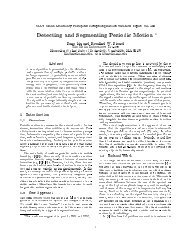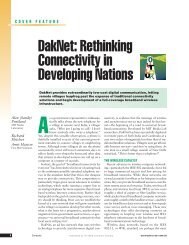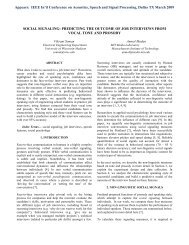Social Serendipity: Proximity Sensing and Cueing - Human ...
Social Serendipity: Proximity Sensing and Cueing - Human ...
Social Serendipity: Proximity Sensing and Cueing - Human ...
You also want an ePaper? Increase the reach of your titles
YUMPU automatically turns print PDFs into web optimized ePapers that Google loves.
section, mobile social software application must be designed to work with the varying<br />
privacy concerns of a diverse user community.<br />
<strong>Proximity</strong> Webpages. The application provides the user the option to view any information<br />
a proximate person has deemed public, regardless of their similarity score.<br />
While most interactions instigated by <strong>Serendipity</strong> require information to be sent to<br />
both users, proximity webpages allow users to simply see public profiles of nearby<br />
people without disclosing information about themselves.<br />
Alternate Introduction Mediation Techniques. Although the current matching<br />
algorithm simply looks at similarity thresholds <strong>and</strong> scores described above, there are<br />
many other methods of matchmaking. One such approach described by Terry et al,<br />
relies on a mutual friend to make the introduction [14]. Such a method can be<br />
incorporated into <strong>Serendipity</strong> by alerting the mutual friend rather than the two<br />
individuals. Alternatively, to preserve a user's privacy <strong>and</strong> to minimize disruption we<br />
also have enabled a feature of sending only an anonymous text message alert that there<br />
is a person nearby who shares similar interests; both users must respond "yes" to<br />
actuate the dissemination of any personal information.<br />
5 User Studies<br />
The <strong>Serendipity</strong> system has been tested <strong>and</strong> iterated upon<br />
for almost one year. There are currently one hundred<br />
<strong>Serendipity</strong> users split between two university<br />
departments. Although the study has officially only been<br />
running for several weeks, <strong>Serendipity</strong> has undergone a<br />
preliminary deployment of forty users during a day-long<br />
conference earlier this year. The feedback from the users<br />
during this initial trial was incorporated into the current<br />
version of the system.<br />
5.1 Initial Deployment<br />
<strong>Serendipity</strong> was initially deployed in early May 2004 at<br />
an elite conference consisting of senior corporate<br />
executives <strong>and</strong> professors. Personal profiles were created<br />
for forty of the conference participants who picked up<br />
their assigned phone upon arrival in the morning. Over<br />
one hundred introductions were made over the course of<br />
Fig 4. Executives introduced<br />
at a conference with<br />
<strong>Serendipity</strong>.<br />
the day, primarily during the inter-session coffee breaks. As it was the first time the<br />
system was deployed, a significant amount was learned about these types of situated<br />
introductions that helped refine the system in subsequent versions.






